What is a performance management system?
A performance management system is a range of tools, actions and methodologies that are used to consistently track employee performance.
An effective performance management system goes beyond once-per-year appraisals. To build a high-performing workforce, creating a system which aligns personal goals to company values and objectives is key.
The best performance management systems adopt a holistic approach.
For an employee to perform at their best, they need to understand how the work they do impacts the organisation as a whole. Cultural alignment as part of performance management should involve real-time, actionable feedback against goals which are tied to company objectives.
Understanding the tools and techniques to make the most of your performance management system.
There are several types of performance management system approaches that HR leaders and managers can use throughout the lifecycle of their employees. Perhaps the most significant of these is one that pairs a performance management system with employee development.
Good performance management software can significantly enhance an employee’s ability to deliver on the requirements of their job responsibilities when these responsibilities are set in tandem with learning and training.
The benefits of implementing a performance management system
Using a performance management system can bring a wide range of benefits to your company. Performance management processes don’t have to be time-consuming, with available tools such as customizable templates and scheduled reporting.
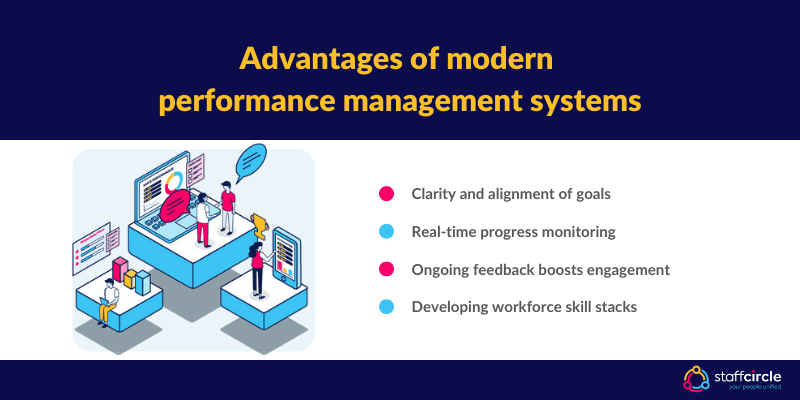
Advantages of modern performance management systems
- Clarity regarding individual, team and company-wide goals so that everyone is aligned.
- Real-time monitoring of progress towards achieving goals and understanding what drives performance.
- Ongoing feedback to strengthen relationships while boosting motivation and engagement.
- Developing individual and team talent stacks to create a workforce capable of creative solutions and innovations.
Let’s take a closer look at the key features and components of a performance management system that you can use to get the best results from individuals and teams.
Setting goals and aligning teams with a performance management system
Creating dynamic goals within your performance management system is a must. Goals which align employees’ ambitions with the company’s core mission are far more likely to be achieved than those set in isolation.
The ability to modify these goals throughout the employee performance management and development cycle can be achieved through feedback alongside data analytics, so that goals are always achievable.
The role of a human resource department in performance management
The role of HR and management is to help employees understand the link between their personal goals and the overall organisational strategy. This link enhances the sense of meaning in an individual’s career, which can help motivate employees and improve employee retention.
Audacious goal setting
Ambitious performance management goal setting, which encourages employees to think big is a great way to enhance motivation and engagement. These audacious goals are particularly effective for motivating the high performing employees in an organisation, however it is important to make them achievable so you don’t lower employee engagement.
Using the SMART goal method for more achievable objectives
For the more pragmatic goals relating to the day-to-day workload of employees, SMART strategic goals are the way to go. An acronym for Specific, Measurable, Achievable, Relevant, and Time-bound, these performance management employee goals help individuals and teams focus on delivering measured results that contribute to ongoing projects and other duties.
Linking individual goals to organizational goals
One of the key elements of using a performance management system is that you are able to structure your goal setting process in a way that keeps employees informed and motivated. This enables managers to set individual objectives that tie into departmental targets, and even organizational objectives.
Your workforce is able to discuss performance with a clearer mind of how each individual target affects and contributes towards business success. Understanding the effect that individual performance has on the company as a whole encourages high performance that is future focused.
What are the stages of the performance management cycle?
The most effective performance management systems are built around a multi-stage cycle.
Common performance management cycles include:
Planning phase
Before setting any personal development goals for an employee, it’s key that the business understands how their contributions factor into company aims.
From this, clear SMART objectives can be outlined and agreed upon by the employer and the employee together.
Monitoring progress
Communication is key for this phase of the cycle, with traditional once-per-year appraisals no longer enough.
High performing organisations value a more rounded performance management system, including regular check-in’s, real-time feedback and employee engagement strategies.
Review progress
It’s important to monitor employee performance and development regularly to maintain high performance, using employee data and insights.
Leaders should take time to understand the analytics to ensure OKR’s are realistic, achievable and still aligned to overall company goals.
Recognise and reward
Motivating a high-performing individual to continue their work and stay with your company is a vital part of the cycle.
This doesn’t necessarily mean an annual payrise or promotion. Employees can be recognised in a number of different ways, so it’s vital to find the best method for each individual.
Tracking progress towards objectives in real-time with performance management software
One of the core elements of performance management processes lies in the ability to track progress towards the completion of business objectives and individual goals in real-time.
This is best achieved by using a performance management system to set clear metrics that measure success and failure, which are understood by everyone involved.
Performance management tools allow managers to set these metrics, and then break them down into easy to interpret measurements that can be easily tracked. This data can then be reviewed on a regular basis, allowing for real time feedback that creates a continuous performance management cycle in which potential problems can be spotted and addressed early.
Measuring employee goals through performance management systems
The way each business chooses to evaluate performance can differ depending on organizational strategy, but there are two main outlines for ongoing performance conversations.
Objectives and Key Results (OKRs)
Role-related employee goals with tangible expected results can be tracked via objectives and key results (OKRs). Metrics relating to output, sales and other measures can be easily tracked via this method.
Key Performance Indicators (KPIs)
Key Performance Indicators are versatile metrics which HR leaders and managers can apply to a broad range of expected outcomes, including the development of soft skills and other measures relating to employee performance and progression.
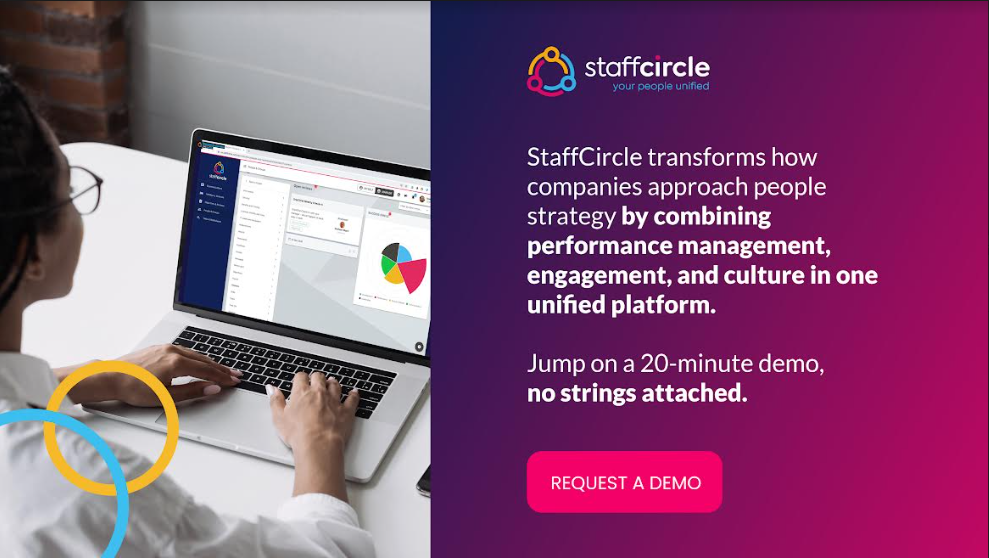
INTEGRATING GOALS INTO PERFORMANCE MANAGEMENT TOOLS WITH CUSTOMISABLE REPORTING
Understanding how well progress is being made towards organisational objectives requires the use of key components of a performance management system. These include:
Dashboards for KPIs and OKRs
Managers and employees alike can use real-time dashboards within their performance management system to track their KPIs and OKRs. Since these dashboards can be tailored by the user, they can be set up to focus on specific metrics and goals to keep employees aligned with the most important tasks.
Today Screen function for daily insight
A Today Screen allows users to view a snapshot of the day’s expectations. Current objectives can be seen alongside other responsibilities – for instance, any upcoming meetings or reviews – to assist with time management.
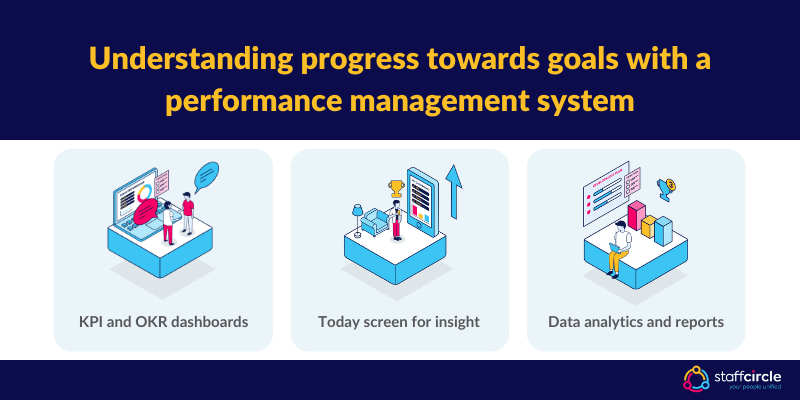
Data analytics and reporting
Performance management systems provide a comprehensive range of information that can be used by HR leaders and managers to influence a constantly evolving workforce.
Using a data analytics and reporting feature allows managers to break this information down and view what matters the most to employee performance and goal management. Customisable reports can be automated and scheduled to save valuable time and energy.
Conducting frequent performance reviews and appraisals
Just as tracking and updating objectives should be considered as a continuous performance management process, managers and HR leaders should also make ongoing feedback a core component of their performance management process.
These ongoing conversations improve a number of important factors which drive better performance management, from how effectively employees are meeting their individual goals, to what new training they require to be able to improve their contribution towards organisational objectives.
The importance of continuous feedback
A report from Gartner highlighted the importance of ongoing, forward-looking feedback:
“Organizations that make performance reviews forward-looking, not backwards-looking, can expect to improve employee performance by as much as 13%. Those that provide ongoing, not episodic, feedback could get a boost of as much as 12%. The third key plank of performance management is peer feedback, which can enhance performance by as much as 14%.”
This feedback can be framed through a variety of mechanisms which can be implemented in an ongoing manner.
Performance management feedback mechanisms
There are numerous methods of providing feedback on employee performance, whether they are high performers or their current performance could improve.
Understanding the performance potential that each feedback mechanism will deliver is an important aspect of an effective performance management process. Performance reviews can take many forms, with some creating a more effective performance management system than others.
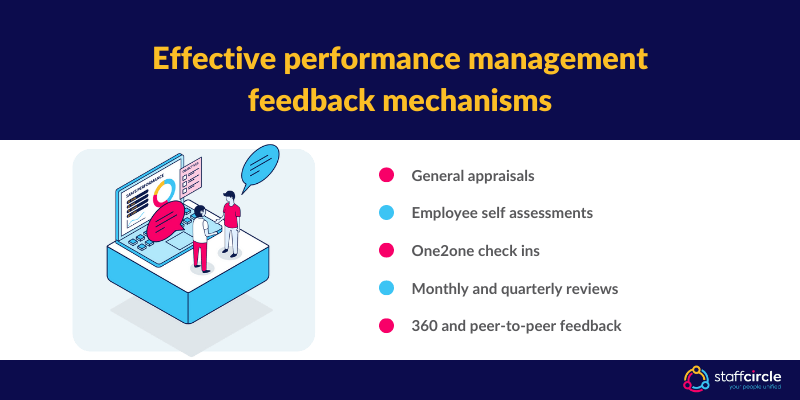
However, whichever combination you decide to use in your performance management cycle, it’s important to understand how frequent feedback, employee recognition and constructive performance appraisals can lead to the development of high performers.
General appraisals
Regular one2ones and check-ins carried out as part of an effective performance management system should be used on a weekly basis to allow managers and team leaders to connect with employees on day to day concerns.
These appraisals should cover a general approach to employee performance-related issues, a continuous progress review, performance measurement and key points that will result in improving performance.
Examples of performance conversations using a continuous performance management system
- Any issues delivering on goals and objectives, including obstacles to success and a lack of resources necessary to perform duties.
- Well-being issues that might be impacting an employee’s ability to deliver results.
- Problems with other team members and colleagues which need to be addressed, and a general discussion of an employee’s role within their department.
- Building rapport and enhancing relationships with staff. Allow time to discuss non-work topics to better understand what motivates employees outside of the workplace.
Employee self-assessments
Objective data on employee achievements only goes so far when it comes to shedding light on issues related to employee performance. Employee self-assessments offer another layer of insight to the performance management cycle to help HR leaders and managers make important decisions regarding the development of individuals.
How employee self-assessments improve performance management
Using a performance management system for regular self-assessments can illuminate personal and professional hurdles employees are facing that otherwise might remain hidden from view.
With many employees working remotely these issues can be much harder for managers to identify without the face-to-face interactions found when working in shared offices.
One2one check-ins
One of the principal functions of ongoing feedback is providing real-time information which can be used to address employee performance issues. Regular one2one check-ins allow managers and team leaders to build trust with employees and improve performance with valuable insights.
Using performance management dashboards to enhance a performance review
By using dashboards as part of performance management tools, managers and employees are able to plan for and schedule regular meetings. With ongoing conversations a core element of the working schedule, participants can prepare relevant data to keep the discussions on point.
Monthly and quarterly reviews
Small businesses undergoing rapid growth are especially disadvantaged if they are still stuck using annual reviews as part of their performance management cycle. When reviewing employee performance using annual reviews, many factors surrounding behaviours and results can be overlooked.
The benefit of more frequent performance reviews
By switching to quarterly or even monthly reviews, HR leaders and managers can keep track of the core dynamics affecting an employee’s performance. Performance management software allows users to automate reviews with customizable templates for ease of use. By structuring the review process, small businesses can help ensure they are regular and consistent.
360 and peer-to-peer feedback
360-degree and peer-to-peer feedback provide insight into an employee’s performance by asking fellow team members and direct reports about their work habits. These feedback requests can be easily set up as regularly recurring surveys through customized templates to ensure delivery on a regular basis.
Motivating and engaging employees
People often say that motivation doesn’t last. Well, neither does bathing — that’s why we recommend it daily.
Zig Ziglar, motivational speaker
A performance management system features several components which HR leaders and managers can use to motivate employees and boost engagement.
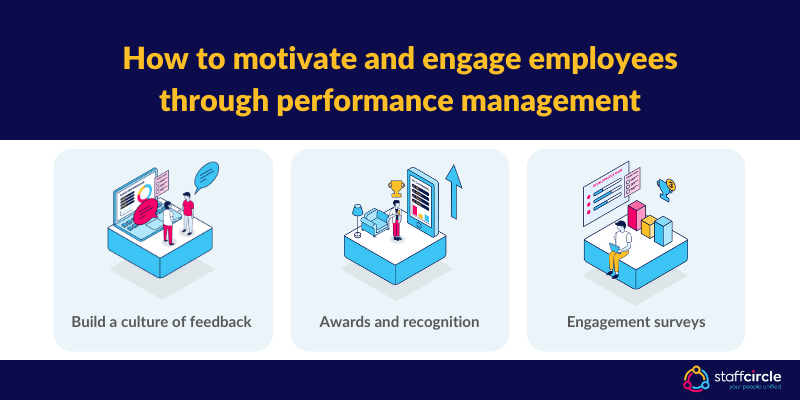
Build a culture of feedback
A company’s culture should embody the values which matter most to its core vision to promote business success. Ongoing feedback and regular constructive conversations should be one of the key pillars of your culture strategy and performance management cycle, boosting employee engagement.
Introduce awards and recognition programs
Employees perform to a much higher standard when they feel that their input into organizational goals is valued. Award and recognition programs can be built into the architecture of a performance management system so that the visibility of praise and rewards is maximized.
Real time feedback and peer-to-peer recognition programs add an additional layer of positive feedback beyond the recognition given by managers. The ability to celebrate the achievements of colleagues boosts overall confidence while encouraging a healthy degree of competition.
Employee recognition in a modern performance management system
Good performance can be recognized and rewarded through a range of performance management activity.
Whether you choose to implement line manager awards, human resource department recognition or real time feedback from colleagues and peers, using a performance management platform makes it simple.
Conduct employee engagement and sentiment surveys
Regular surveys – for instance, Employee Net Promoter Score (eNPS) surveys – give HR leaders and managers a performance snapshot and continuous feedback about how the workforce feels about their progress.
The data allows business leaders can better identify any departments which might be experiencing engagement issues that are inhibiting good performance.
Employee development initiatives
Performance management software for businesses isn’t just about keeping employees focused on achieving their current objectives. It’s also about ensuring they develop the skills and abilities to perform above and beyond the baseline expectations.
The importance of building employee talent stacks
A Harvard Business Review article states: “As more aspects of work become automated, it is increasingly important for people to focus on building skills that support creative and innovative tasks only human beings can perform.”
Developing individual and team skill stacks within your performance management cycle doesn’t just encourage improved performance and active learning. The right performance management software enhances your organizational strategy, highlighting opportunities for development or promotion.
Improving employee development using performance management systems
High performing companies understand the need to invest in employee learning and development. A performance management system offers the necessary evaluation capabilities to pinpoint areas that can be improved through training.
Establishing personal development plans and setting up performance improvement plans
Employee development begins when they first start at the company. The onboarding process should include the creation of Personal Development Plans (PDPs) which help HR leaders and managers understand the skills they are bringing to the organization, and the tools and resources they may require to enhance those skills and develop new ones.
These plans are invaluable reference points throughout an employee’s tenure, and can be augmented by performance improvement plans should they find themselves struggling to fulfil their duties.
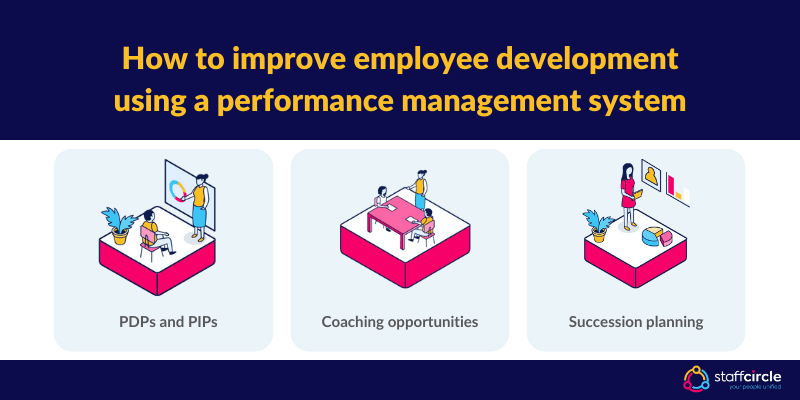
Providing opportunities for coaching and mentoring
Employee development is naturally tied to coaching and mentoring, and HR leaders and managers should view this as a continuous process. Tracking OKRs and KPIs, understanding absence and sickness patterns, and bringing the ongoing review process back to personal development plans all help guide decisions about learning.
Additionally, the use of a performance management suite’s people and skills databases allows HR managers to connect employees with complementary skills from across the organization. This allows companies to maximize how the various talents within their organization are used, connecting them via social intranet, forums and dedicated channels in Microsoft Teams.
Dealing with succession planning
A performance management system also allows leaders to identify those employees with the necessary soft skills to become great leaders themselves. Leaders who are cultivating employees for management positions can draw upon their performance management data to gain a clearer insight into a variety of relevant competencies.
Performance management systems:
- Allow users to plan for career development conversations
- Recognize and prioritize talent development opportunities
- Give a clear overview of employee progress during their time with the company
- Rank employees so that high potential employees are highly visible
Using a performance management system to promote your company’s mission and culture
Definitions of a company’s culture can often be difficult to pin down. Culture reflects the core beliefs of an organisation, and as such is prone to change over time as a company grows. Taking the time to articulate the core values of an organization can help achieve much greater alignment between employees and business owners.
Defining the company’s core values
The first thing to understand about company values is that they exist within the core framework of the organization. Whether or not they have been successfully articulated, these values guided the establishment of the company. As such, the leadership team is in the perfect position to discuss exactly what these are and how they can be expressed.
Examples of core values
- Continually striving for perfection
- Doing the right thing
- Leading with compassion
- Encouraging individual ability and creativity
- Treating everyone with respect
- Oriented toward growth
- Encouraging teamwork
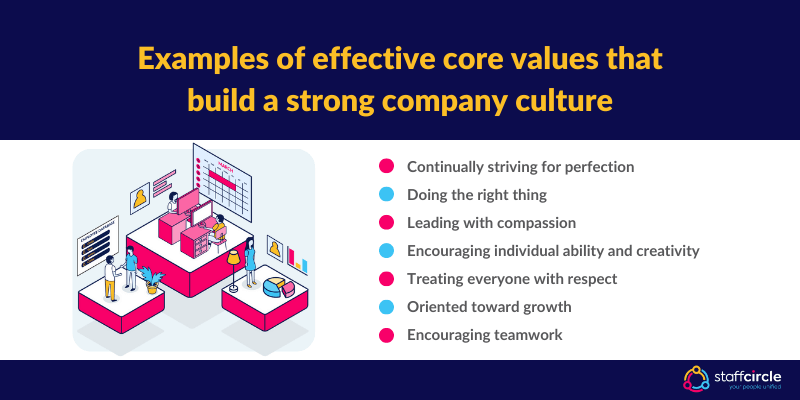
Whatever core values are selected to best represent an organization, they should underpin the fundamental “why” of the organization’s purpose. Culture shouldn’t simply represent the “what” of a company’s surface functions but instead, reflect the ethos which drives the engine.
Promoting core values through a performance management system
Once the core mission and values have been determined, they need to be clearly expressed throughout the workforce. This can be achieved through:
Branding
Customizing your performance management system and introducing branding across the app can help boost the visibility of cultural values. Make sure these are consistent across processes and throughout a multi-channel communications platform.
Onboarding processes
The ideal time to articulate cultural values is during the onboarding phase. New employees need to be immediately brought up to speed on what is expected of them. Onboarding provides an opportunity for HR leaders and managers to deliver the necessary documentation which outlines the core mission and expected behaviours.
Putting culture feedback systems in place
When defining a company’s culture, business leaders need to consider a variety of factors.
- History and ownership. New organizations and small businesses looking to expand lean towards adaptability. A flexible approach allows for quick adjustments as the business continues to grow.
- Size. Larger organizations often run the risk of becoming impersonal. Small business owners have the advantage of being able to more easily create organizational cohesion.
- Organizational goals. Business goals are rarely as clear cut as “making a profit”. Employees need to identify with something which transcends the bottom line and connect with something more meaningful.
- The workforce. An organization is composed of a range of individuals with different talent stacks and levels of experience. Company culture should reflect this composition and amplify the positive traits which reflect the broader mission.
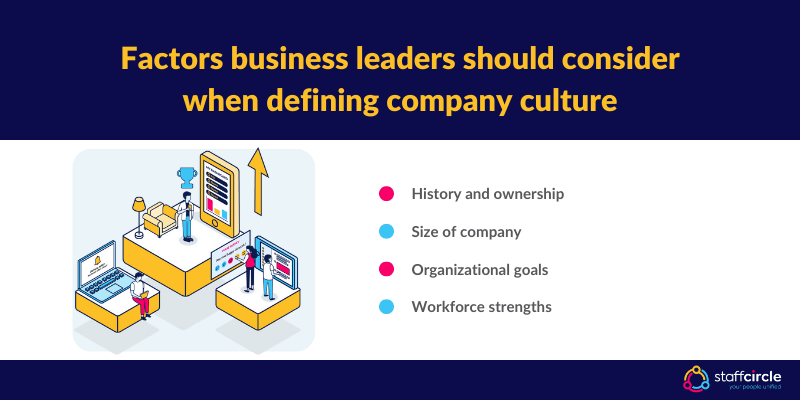
The role culture plays in employee performance management
In his book Start With Why, Simon Sinek sums up the role culture plays within an organization and performance management framework:
“A company is a culture. It’s not products or services that bind a company together. It’s not size and might that makes a company strong; it’s the culture – the strong sense of beliefs and values that everyone, from the CEO to the receptionist, all share. So the logic follows, the goal is not to hire people who simply have the skill set you need, the goal is to hire people who believe what you believe.”
By setting in stone a clear and unifying culture, small business owners can ensure their growth and development aligns with the people their organization is composed of. When hiring and onboarding new members of staff, this culture can be clearly expressed to see if they are a good fit for the team.
As an employee’s role develops over time, culture feedback mechanisms can be used to ensure the vision and culture are dynamic. Direct feedback from employees can enhance the company’s core values. Technical and professional competencies which encourage great performance can be amplified. By recognizing positive behaviours the company’s culture is strengthened and the bond between employee and employer is enhanced.
Establishing consistent communications throughout the workforce
Small businesses are not immune to the shift towards hybrid working. Many companies have adapted to the post-pandemic landscape with a completely different workforce layout, split between office-based, hybrid and remote working. This presents new challenges for small business owners seeking to maintain the integrity of their internal communications.
A performance management system for small business requirements should include a multi-channel communications platform. Such a platform allows business leaders to integrate their values throughout communications, for instance by embedding them in HR processes.
Using a multi-channel communications platform
Multi-channel communications are useful for more than boosting culture. They can bring employees together in a variety of other ways to improve organisational integrity. These comms allow users to instantly contact one another across a range of platforms. Desktop and laptop devices can be used alongside mobile phones, with instant alerts hitting all channels.
Performance management systems allow users to access a range of useful tools. These include:
Newsfeeds
Newsfeeds allow managers and team leaders to circumnavigate the pitfalls of group emails and deliver information knowing it has been read and understood. Articles and other important documentation can be sent along with an alert, with employees able to sign off to confirm receipt.
A news feed within a performance management system has the additional advantage of being tailored to individuals, teams, departments and locations. The option for users to like and comment on items in the news feed allows these updates to stimulate important conversations about what matters the most.
Social intranet
Employees deliver their best work when they are able to communicate ideas with their colleagues clearly and effectively. A successful workforce is built upon collaboration, and a social intranet provides the foundation for productive interaction.
Staff updates, company news and other initiatives can be promoted by small business owners through a social intranet housed within performance management software. Innovations within the company and updated practices can be articulated, with users contributing valuable feedback as part of ongoing conversations.
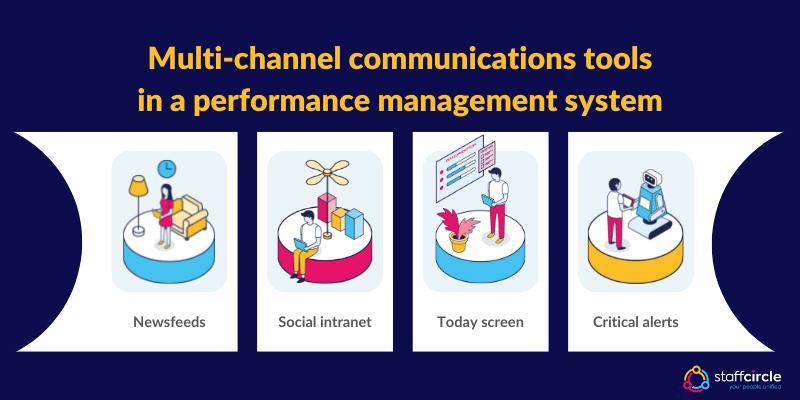
Today Screen feature
One of the biggest obstacles to efficiency is a lack of organisation of priorities. A Today Screen allows users to collate the most pertinent information in one place in real-time so they can focus on what matters the most. It also allows managers and HR leaders to gain a birds’ eye view of the organization and adopt a proactive stance on potential issues.
The Today Screen in StaffCircle’s performance management system is fully customizable and can be tailored to display a range of information, including:
- Upcoming scheduled meetings
- Feedback sessions, for instance, one2ones and check-ins
- Crisis communications
- Organizational charts
- Current objectives and goals
- Videos, articles and important training resources
Critical Alerts
When small businesses are faced with emergencies or need to quickly disseminate other crucial information, multi-channel communications can be used to send critical alerts. These high priority messages are sent from performance management systems, instantly delivered across all platforms, including push notifications and SMS alerts to mobile devices.
Recipients are able to respond to these alerts via email or SMS directly within the performance management system. These responses are then automatically sent to the manager who issued the alert. The ability to automate alerts offers managers and team leaders additional flexibility when communicating to individuals, teams and departments.
Effective communication supports an effective performance management process
Defining and improving company culture is a performance management process that should involve everyone in an organisation. Culture feedback mechanisms can be used to bolster alignment and give business leaders additional insights into how their mission and values can be updated to better reflect individual and team experiences.
Performance management tools found within performance management software can allow HR administrators and managers to set up customized employee sentiment analysis, for instance, Employee Net Promoter Scores (eNPS). Data from these surveys can assist with the realignment of core values, identifying problem areas that need to be addressed.
Choosing an effective performance management system for your business
A performance management system needs to be oriented towards the broader strategic aims of the organization.
As an individual’s abilities grow, they should be closely tied to both short- and long-term goals desired by the company’s leadership.
This includes consideration for potentially expanding the scope of an organisation, for instance, if leaders are considering expanding their line of products or services into new sectors.
Business leaders and managers can use a performance management system to gain insights into the people needs of the organization through the use of HR administrative tools embedded in their performance management system.
Maximising the raw potential of a business requires a deep understanding of its constituent parts. A production line needs a complete inventory of the resources available. Similarly, business leaders and executives need an overview of their company’s people resources.
People databases
People databases within performance management systems allow HR professionals to input and track the core skills and abilities of the company’s employees. This database can also incorporate details on contractors and candidates, ensuring that HR leaders and managers can make the best hiring decisions.
Additionally, such databases provide a central hub for other employee-related information. This can include the department they are working in, their job title, location and other important contact details.
Organizational charts
On a broader level, organisational charts allow HR leaders and managers to map individuals in the company and how they fit into teams and departments. Not only does this allow users to see how employee roles fit into the bigger picture, it also offers a formal outline of the company’s structure so that new positions can be identified and people with the right skills assigned to them.



